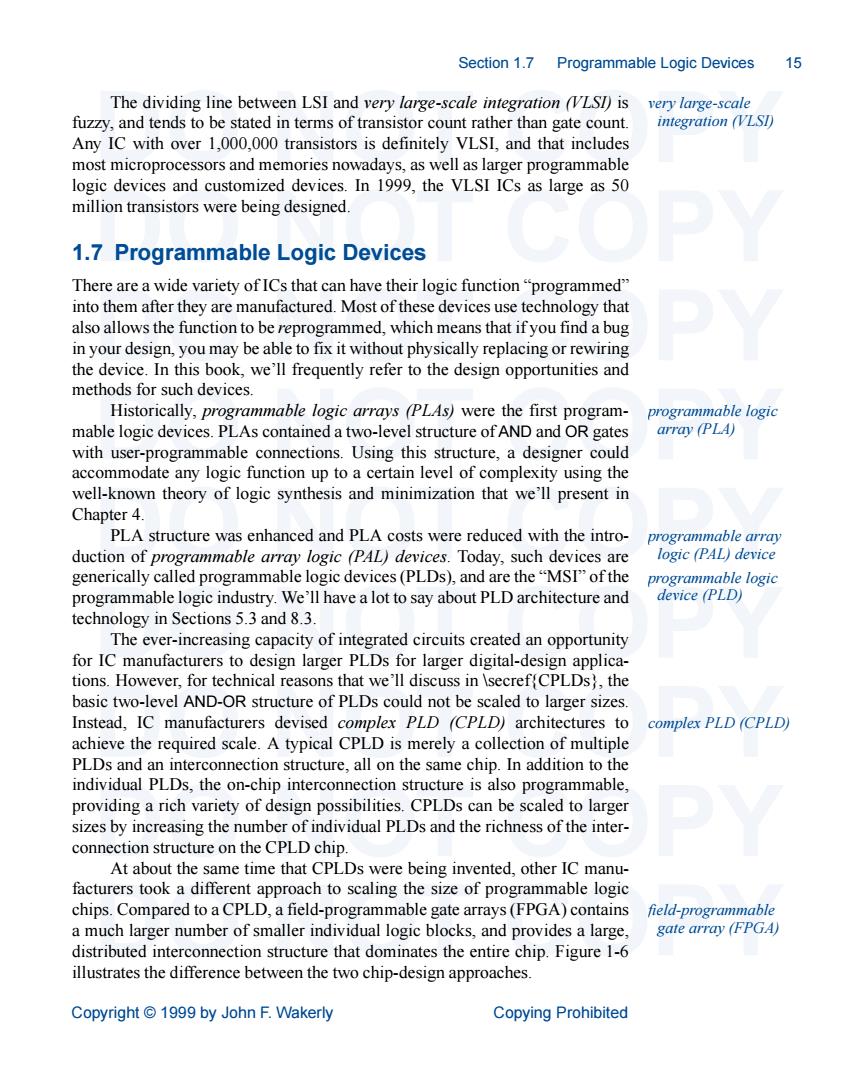正在加载图片...

Section 1.7 Programmable Logic Devices 6 The dividing line between LSI and very large-scale integration (VLSI)is very large-scale fuzzy,and tends to be stated in terms of transistor count rather than gate count. integration (VLSI) Any IC with over 1,000,000 transistors is definitely VLSI,and that includes most microprocessors and memories nowadays,as well as larger programmable logic devices and customized devices.In 1999,the VLSI ICs as large as 50 million transistors were being designed. 1.7 Programmable Logic Devices There are a wide variety of ICs that can have their logic function"programmed" into them after they are manufactured.Most of these devices use technology that also allows the function to be reprogrammed,which means that if you find a bug in your design,you may be able to fix it without physically replacing or rewiring the device.In this book,we'll frequently refer to the design opportunities and methods for such devices Historically,programmable logic arrays (PLAs)were the first program- programmable logic mable logic devices.PLAs contained a two-level structure of AND and OR gates arrav (PLA) with user programmable conections.Using this structure,a designer could accommodate any logic function up to a certain level of complexity using the well-known theory of logic synthesis and minimization that we'll present in Chapter 4 PLA structure was enhanced and PLA costs were reduced with the intro duction of programmable array logic (PAL)devices.Today,such devices are generically called programmable logic devices(PLDs).and are the"MSI"ofthe rammable logic programmable logic industry.We'll tosay about PLDarchitecture and technology in Sections 5.3 and 8.3 The ever-increasing capacity of integrated circuits created an opportunity for IC manufacturers to design larger PLDs for larger digital-design applica- tions.However,fo technical reasons that well discuss in the basic two-level AND-OR structure of PLDs could not be scaled to larger sizes. Instead.IC manufacturers devised complex PLD (CPLD)architectures to complex PLD (CPLD) achieve the required scale.A typical CPLD is merely a collection of multiple PLDs and an interconnection structure,all on the same chip.In addition to the individual PLDs,the on-chip interconnection structure is also programmable, providing a rich variety of design possibilities.CPLDs can be scaled to larger sizes by increasing the number of individual PLDs and the richness of the inter- connection structure on the cPlD chip. At about the same time that CPLDs were being invented,other IC manu- facturers took a differ appro pach to scaling the size of progra able logic chips.Compared to a CPLD,a field-programmable gate arrays(FPGA)contains field-programmable a much larger number of smaller individual logic blocks,and provides a large. gate array (FPGA) distributed interconnection structure that dominates the entire chip.Figure 1-6 illustrates the difference between the two chip-design approaches. Copyright 1999 by John F.Wakerly Copying ProhibitedSection 1.7 Programmable Logic Devices 15 DO NOT COPY DO NOT COPY DO NOT COPY DO NOT COPY DO NOT COPY DO NOT COPY DO NOT COPY DO NOT COPY DO NOT COPY Copyright © 1999 by John F. Wakerly Copying Prohibited The dividing line between LSI and very large-scale integration (VLSI) is fuzzy, and tends to be stated in terms of transistor count rather than gate count. Any IC with over 1,000,000 transistors is definitely VLSI, and that includes most microprocessors and memories nowadays, as well as larger programmable logic devices and customized devices. In 1999, the VLSI ICs as large as 50 million transistors were being designed. 1.7 Programmable Logic Devices There are a wide variety of ICs that can have their logic function “programmed” into them after they are manufactured. Most of these devices use technology that also allows the function to be reprogrammed, which means that if you find a bug in your design, you may be able to fix it without physically replacing or rewiring the device. In this book, we’ll frequently refer to the design opportunities and methods for such devices. Historically, programmable logic arrays (PLAs) were the first programmable logic devices. PLAs contained a two-level structure of AND and OR gates with user-programmable connections. Using this structure, a designer could accommodate any logic function up to a certain level of complexity using the well-known theory of logic synthesis and minimization that we’ll present in Chapter 4. PLA structure was enhanced and PLA costs were reduced with the introduction of programmable array logic (PAL) devices. Today, such devices are generically called programmable logic devices (PLDs), and are the “MSI” of the programmable logic industry. We’ll have a lot to say about PLD architecture and technology in Sections 5.3 and 8.3. The ever-increasing capacity of integrated circuits created an opportunity for IC manufacturers to design larger PLDs for larger digital-design applications. However, for technical reasons that we’ll discuss in \secref{CPLDs}, the basic two-level AND-OR structure of PLDs could not be scaled to larger sizes. Instead, IC manufacturers devised complex PLD (CPLD) architectures to achieve the required scale. A typical CPLD is merely a collection of multiple PLDs and an interconnection structure, all on the same chip. In addition to the individual PLDs, the on-chip interconnection structure is also programmable, providing a rich variety of design possibilities. CPLDs can be scaled to larger sizes by increasing the number of individual PLDs and the richness of the interconnection structure on the CPLD chip. At about the same time that CPLDs were being invented, other IC manufacturers took a different approach to scaling the size of programmable logic chips. Compared to a CPLD, a field-programmable gate arrays (FPGA) contains a much larger number of smaller individual logic blocks, and provides a large, distributed interconnection structure that dominates the entire chip. Figure 1-6 illustrates the difference between the two chip-design approaches. very large-scale integration (VLSI) programmable logic array (PLA) programmable array logic (PAL) device programmable logic device (PLD) complex PLD (CPLD) field-programmable gate array (FPGA)